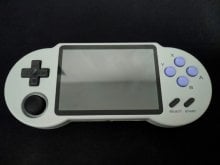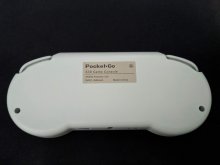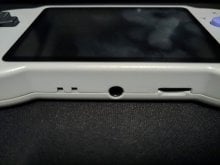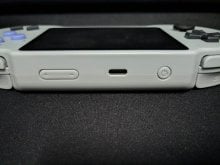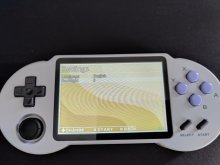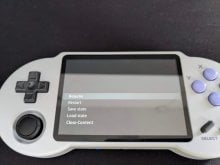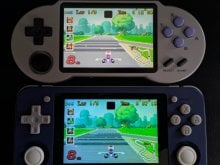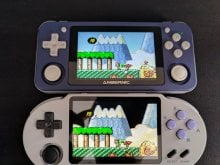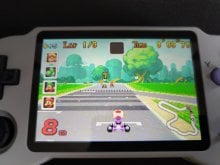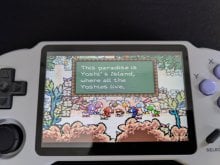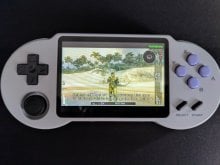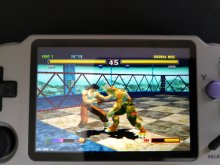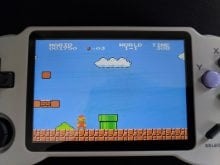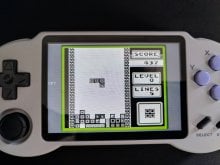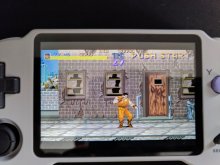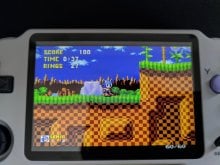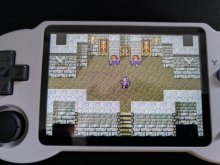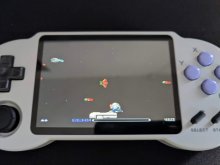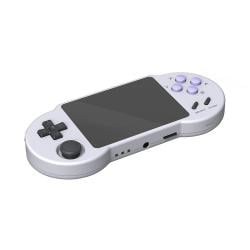 BittBoy PocketGo S30 (Hardware)
BittBoy PocketGo S30 (Hardware)
Official GBAtemp Review
Product Information:
- Official Store: https://retromimi.com/products/pocketgo-s30
What’s nearly universal in the retro handheld market is that these devices adopt a similar, rectangular form factor. They might come from different companies, be of different sizes, and feature different software, but the rectangular aspect is more of the same. It’s not bad and I find it more comfortable to game on than a vertically-oriented device like the Anbernic RG280V. However, it seems like the manufacturers don’t want to try something risky and innovate design-wise. After all, don’t fix what’s not broken, right?
But breaking the mould and trying something unique will make a product standout and, if it works, make it more appealing, especially if it plays on nostalgia which is what the software side of things bet on with those handhelds. Meet the PocketGo 30 from BittBoy.
While also packing a landscape orientation, its design is strikingly different yet familiar as it is modelled after the SNES controller (or closer to the 8BitDo controller). It fits nicely in the hands and if you grew up playing the SNES, holding it will inevitably bring back fond memories. Let’s see if this device will help forge new ones.
Contents and impression
Out of the box you’ll find the following:
- PocketGo S30 handheld x1
- User manual x1
- Charging cable x1
- microSD card x1
When it comes to the build quality, I wasn’t expecting much with the PocketGo S30 as the last BittBoy device I reviewed, the RK2020, had a quite disappointing hardware. However, with the S30, I found things to be much better. There is no light bleed, it charges well, and there’s no rattling of the buttons. However, when I shook it with a little more force, I could feel the internal PCB shake a little, which isn't exactly a good sign. After taking out the casing and tightening the screws, this issue was fixed… only to come back later. While this is not ideal and not a sign of a good-fitting mould, it hasn't yet caused any issues with the device’s performance while in use.
Regarding the buttons, the analogue stick is of quite good quality and is basically the same you’ll find in other handhelds like the Anbernic RG351P or Anbernic RG350P. The ‘Start’ and ‘Select’ buttons are rubberized and have a nice retro feel to them. As for the D-pad and face buttons, they are functional, but don’t offer as satisfactory a feedback as the ones from the Anbernic devices. They are quite similar to the New PocketGo V2 and feel rather plastic-y. The same can be said about the power and volume buttons located at the top. The shoulder buttons also bear a similar quality, and regarding L2 and R2, they tilt back when pressed, rather than press down like the L1/R1. I personally grew fond of this mechanism but they might not be to the preference of others who are used to conventional triggers.
On the underside you can see some indicator lights, a headphone jack, a microSD slot and a speaker outlet. I was saddened to see that this handheld sports only one speaker which offsets the audio to the right. Really, there is enough space on the console to accommodate another speaker, and the newer systems that the device emulates would benefit from stereo audio.
There was also the opportunity to include an HDMI port at the top as this feature has been elusive in retro handhelds of late but the S30 follows suit and didn’t include it. Personally, I use such devices in handheld mode but it’s nice to have the option to hook them to a monitor to play. That said, at the current price of $60, the PocketGo S30 packs decent enough hardware. On this aspect, it seems like the ‘PocketGo’ line from BittBoy packs their best hardware (in comparison to what came from the company before) as the New PocketGo V2 that I previously tested also had decent hardware. With the S30, I am particularly drawn to the SNES controller mould which, in comparison to what’s on the market, deviates from convention with a rather aggressive design that works. But, let’s not judge a book by its cover and see the software side of things.
Specs and software
Regarding the specs, the S30 packs the following:
- Screen: 3.5 inch 480x320 IPS
- CPU: Quad Core 1.2GHZ All Winner A33 CPU
- GPU: Mali400 MP2
- RAM: 512MB
- Storage: External MicroSD
- Battery: 2600 mAh
From those specs, you’ll note that the S30 isn’t a particularly powerful device. It’s still more powerful than the “last-gen” JZ4770-based devices but weaker than the “current-gen” RK3326-based ones. In terms of processing power, it sits somewhere between the RG350P (last-gen) and the RG351P (current-gen). BittBoy told me that they went with an ‘underpowered’ chip (in comparison to the “current-gen” of retro handhelds) with the PocketGo S30 as it is targeted towards more casual retro gamers as it packs a simple system allowing users to easily load ROMs and game with minimal tweaking. And easy to use it is. In fact, it might be the most straightforward of the recent retro handhelds I’ve tried.
To load up games, it’s simply a matter of plugging the microSD to a computer and copying ROMs to it. To add new system’s emulators or even update the firmware, it’s also a simple matter of copy/pasting files, without the need for any additional software. This might sound like how every device should be used - and they should ideally function like this - but they don’t and the S30’s simplicity is its forte.
To put it in perspective, take the JZ4770 devices like the BittBoy New PocketGo V2 or Anbernic RG350P. These come with two separate microSD cards where one contains the OS and the other is used exclusively for ROMs (and music/videos if you wish to use the device for multimedia). Loading ROMs to this microSD is also a simple copy/paste affair. But to update the firmware or add new emulators, you’ll have to go through some extra hoops that involve using new software to access the Linux file systems on the OS microSD. As for the RK3326 devices like the RG351 or RK2020, they come with only one microSD but are also based on a Linux system and by default require an additional software to load ROMs and/or update firmware. On the other hand, these extra steps aren’t required for the PocketGo S30 by default, and it's easy to copy new ROMs to it or update the firmware.
Regarding the stock firmware, it looks like a striped-down EmuElec firmware you’d find on the RG351P or RK2020. The settings are barebones with only brightness adjustment and language select options available. The main menu allows you to scroll through the different systems and selecting them will show the ROMs in the dedicated folder (each system’s ROMs have to be in the appropriate folder - not even as a folder within the emulated console’s folder - as you cannot browse the microSD card on the device itself to look for ROMs). Even most of the emulators’ settings are simplistic, with only a few options available (save/load state, resume/restart/exit).
However, I found this simplicity to be rather refreshing as the other retro handhelds are laden with settings and the need for hotkeys, so something straightforward as the S30 offers is welcome.
When it comes to actual emulation on the stock FW, it’s a mixed bag. Some emulators like the Dreamcast (Flycast), SNES (Snes9x) and gpSP for GBA don’t have the best displays. You might not notice it if you have not used another retro handheld but comparing them side by side, it’s flagrant. The images are pixelated and text appear blurry. Games are playable but are not pretty to look at.
However, these issues come down to the software as the other GBA emulator, mGBA (yes, it came with 2 GBA emulators), that was included had crisp images and text. Thankfully, Retro Game Corps worked on a firmware update shortly after the launch of the device which better optimize the emulators for the S30’s display (and include new homescreen images for the emulated systems). Games across all emulators appear crisp and the display is even comparable to the RG351P’s.
Even if the stock firmware was somehow not optimized for the device itself, its open source aspect allow the community to work on improving it. If you get the PocketGo S30, I highly recommend updating the firmware first (it’s easily done by dragging and dropping files to the SD card) before you load in your favourite ROMs. However, after the update, I noticed that some settings had been lost in the emulators, like with the GameBoy and PlayStation no longer allowing scaling. Hopefully these can be included again in future updates but keep in mind that the settings are very minimal for the time being.
Performance and compatibility test
Just like the RG351P, the PocketGo S30 has a 480x320 resolution, or exactly 4 times that of the GBA (240x160). This 3:2 aspect ratio is perfect for playing GBA games on the system and that’s where the device really shines. But I also found emulating PlayStation on the device to be a real joy, even if the software adds additional bezels to adjust to the aspect ratio. For these and older systems, the S30 works great. I didn’t come across any issues to run games like Tekken 3 and Bloody Roar II on the PlayStation which usually pose a challenge for some handhelds of the JZ4770 line. SNES games that use the Super FX chip also run flawlessly on the emulator.
For more demanding systems like the Dreamcast and PSP, the S30 won’t perform quite as well. After the update, Dreamcast games look much better and games are playable but do suffer from occasional dips in framerate (there’s no means to check the fps with the current emulator unfortunately). With the PPSSPP emulator on the S30, PSP emulation is a hit-or-miss affair. I could get Ridge Racer to run at a playable speed of 30-40 fps. But for this, I had to adjust the settings to have a rendering resolution of 1x PSP and set the frameskip to 1. The latter setting also helps make the choppy audio sound better. Metal Gear Solid: Peace Walker wasn’t so promising as it ran at around 20 fps with the same settings. A 2x PSP resolution does make everything look crisp on-screen but games are practically unplayable, averaging at 17 fps.
That said, even the pricier and more powerful RK3326 devices don’t run PSP so well as they are more of an incremental upgrade rather than truly powerful next-gen retro handhelds. As such, the PocketGo S30 isn’t really that far behind in terms of emulation. Sure it lacks some emulators like N64 that the RK3326 devices have, but that could change down the line, although performance remains to be seen.
As for the emulators that do come with the device out of the box, below are their compatibility. If there are any games in particular you’d like to know the performance of, do write it in the comments section and I will do my best to test it.
NES - PASS!
SNES - PASS!
GameBoy - PASS!
GameBoy Color - PASS!
GameBoy Advance - PASS!
MAME - PASS!
FBA - PASS!
PC Engine - PASS!
WonderSwan - PASS!
NeoGeo Pocket - PASS!
SEGA Mega Drive - PASS!
PlayStation - PASS!
PSP - PASS (some games run at a playable speed after adjusting settings)
Dreamcast - PASS (but games do suffer from dips in performance)
Closing thoughts
What drew me to the PocketGo S30 was its design and I do quite like it, even if its build quality isn’t totally on par with pricier counterparts on the market. However, with a current price tag of $60, the hardware is solid enough and the software functional enough to be considered if you're on a budget. I was even surprised by the overall package it offers, given that it comes from BittBoy and the S30 is easily the best retro handheld from the company that I've tested.
Sure, it won't give you the same premium feel or experience as an Anbernic device, but that premium feel comes at a more premium price. The S30, being on the cheaper end of the retro handhelds spectrum, comes with some caveats like barebones emulators and a rough around the edges out of the box firmware, but it's surprisingly competent for the asking price and has the advantage of being easy to use and packs a nostalgic, unique design for a retro handheld.
Verdict
- Design
- Easy to use
- Runs most emulators fine (after update)
- Affordable retro handheld
- Disappointing stock firmware
- Only one speaker
- Lack of settings in most emulators
- Internal wobbling
